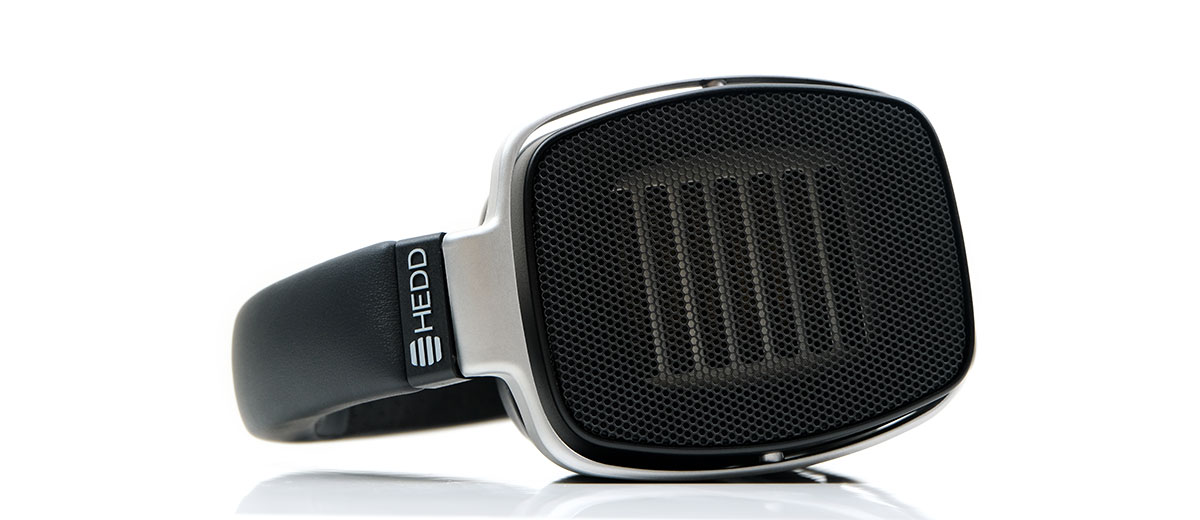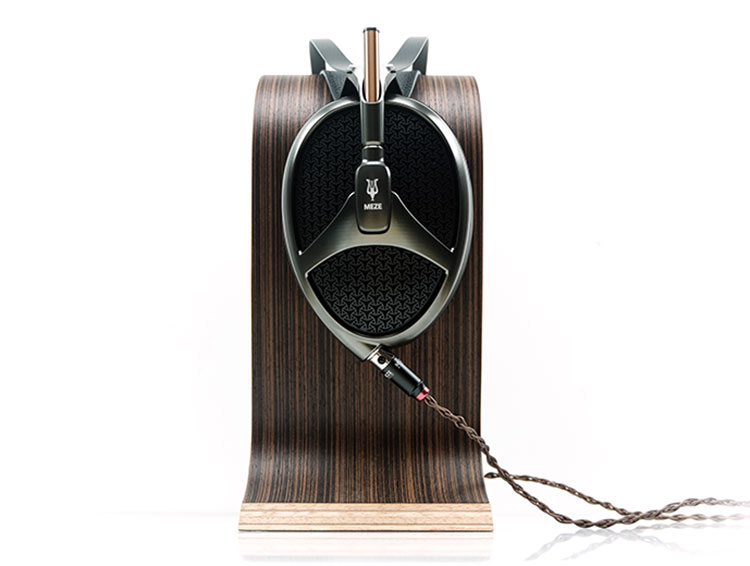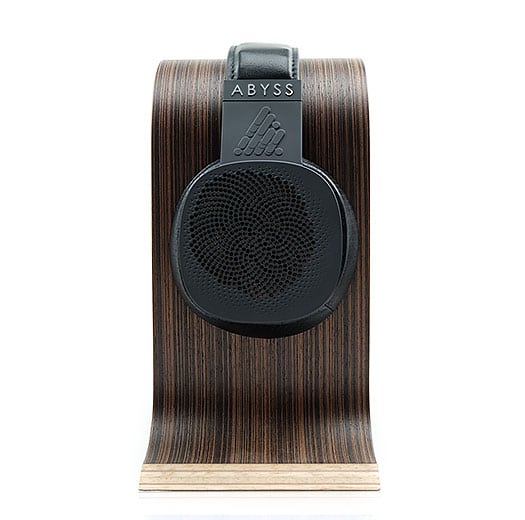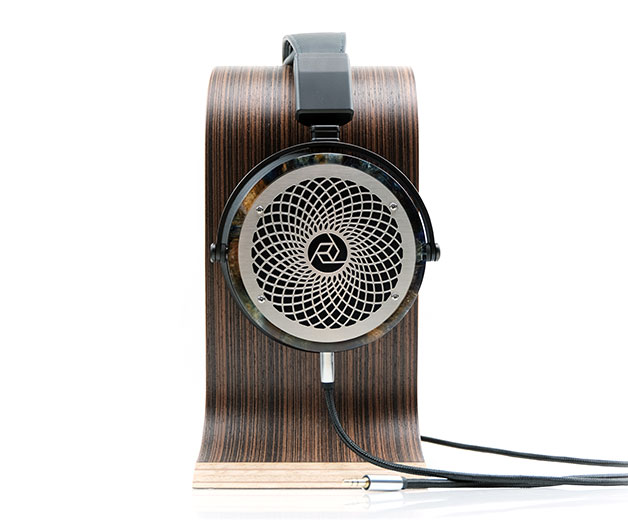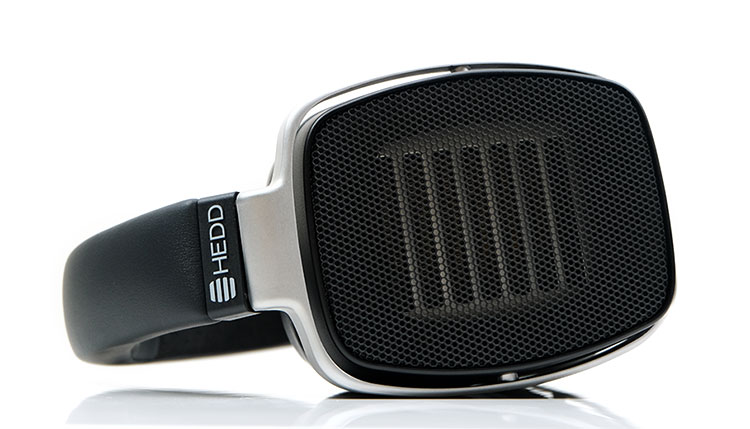HEDDphone Sound Impressions
Summary
A different driver than dynamic and planar and thus a different quality to the sound. Not just in timbre for example but in the way it is presented making it quite unique and remarkably interesting to my often jaded ears.
If not for that subterranean extension on the low end you could almost call it a quasi-electrostatic-like sound mixing some of the better density of planar drivers with that incredible articulation you tend to hear from the electrostatic treble.
Clarity
This does not mean the HEDDphone is bright or treble-centric which is often the interpretation when you mention electrostatic headphones. Far from it. Rather the emphasis is on excellent clarity and extension rather than overt forwardness.
That perception of clarity also extends down to the bass response which is incredibly tight with a superb extension right into the sub-bass performance. Particularly so if you can switch to a balanced setup where the bass physicality gets a little peppiness to it compared to the stock unbalanced sound.
Low-end Presentation
The second caveat continues with the low end. If you are coming from planar drivers it has an entirely different but equally wonderful presentation. There is less of that sustained physicality through the mid-bass with a linear or neutral curve from 50Hz to 300-400Hz then a slight drop into the lower-mids from there to 1k.
The bass punch is therefore quite tight but considerably less aggressive or warmed up compared to something like an Empyrean or RAD-0. It does however extend much deeper with no perceptible diminishment in sub-bass presence.
This only serves to enhance that sense of excellent space and depth on the HEDDphone’s low-end. When called upon you can hear the absolute bottom of any track with superb rumble so to speak but it presents to your ears more neutrally rather than ram it down your canals.
A wonderful example of that style of presentation and how well it fits with some music is Dan Terminus’ Friendship Through Clear Plastic Walls from his 2017 Automated Refrains album.
This is a very slow and languid synthwave track that is heavy on atmospherics and a vast sub-bass performance. With the likes of the Empyrean or RAD-0, I get copious amounts of physicality but not quite the same sense of space that the track is meant to convey.
That massive sense of scale is reproduced almost perfectly for me with the HEDDphone. It sounds huge but also incredibly clear, particularly with a balanced pairing from a good quality amp such as the dCS Bartok.
Staging
And it is here where I think you will find what makes the HEDDphone so special and different.
In some ways, aspects of the HD800 sense of wide-open space are there with the HEDDphone but this goes much deeper without sounding diffuse and indiscriminate in how it throws out those all-important imaging cues that give you a sense of perspective.
It does not sound artificially wide though with less of a distinct left/right separation that can often break up the balance of a musical passage forcing you to keep up with any extreme pan and scan effect.
At times there is an almost oratory level of staging capability pushing you right back allowing huge ensembles time and space to make themselves heard when required. It is a wonderful tool for classical music, atmospheric synthwave, and anything that needs a lot of space to express itself properly.
However, that does not mean vocals are sucked out, distant, or lacking in any character. The HEDDphone does have a notable bump around 2-4k and in all reality, the entire midrange has a very slight forwardness to it which means intimate vocal orientated tracks do have some solidity for voicing.
Importantly, the space around the vocal combined with a very light lower-mid dip and that linear mid-bass presence allows them to breathe and remain very clear in the mix.
Timbre
The HEDDphone timbre is relatively neutral and not as euphonic or rich sounding as either the Empyrean or the RAD-0. However, it is not as light or bright as the Abyss Headphones Diana variants but there are elements of a clean character in its mids and especially in the treble tone.
I suspect that the forward 2-4k tuning is picking up a little upper treble harmonic overtone but not too much to invite unnecessary sibilance or overly sharp attack in percussion or vocal performances. Rather it prevents the mids from coming across as overly liquid or soft sounding.
If you compare the timbre and tone to something like the Empyrean it is not quite as rich or euphonic sounding which might translate to a more satisfying level of tonal accuracy for some.
However, the lower-mid dip combined with the linear mid-bass tuning might rob heavy-hitting metal rhythm guitar chords of a bit of necessary bass fundamental that is needed to translate into weight and power. The HEDDphone timbre here comes across more as clean and precise than wet and weighty.
I do encourage you to demo different amp pairings because there is a degree of transparency here with the HEDDphone and timbre does change a bit with certain setups.
I definitely preferred a warm and sweet analog amp over anything sterile or dry. For example, amps such as the natural-sounding dCS Bartok or the more affordable Monolith Liquid Platinum brought some welcome body and smoothness to the table that I much preferred over the more precise but neutral Chord TT2.
Synergy
Portability
The HEDDphone’s rating of 42Ω and 87dB SPL is really all about amplification shaping that delivers excellent current even at lower voltage levels. In a way, the HEDDphone operates much in the same way as a planar in terms of being relatively voltage agnostic. That does not mean a lower voltage portable solution is ‘the’ way forward but there are a few that might do better than most.
For example, using ALO Audio’s excellent Salty Pepper balanced XLR with a 4.4mm balanced converter, the HiBy R8 in high gain Turbo Mode (1W into 32Ω) has no issues with volume topping out at about 60 steps which were well within its limits. The Luxury & Precision P6 did not seem overly troubled either for current at 50 steps in high gain going balanced.
However, once you start ramping up the amplifier’s capability both sources sound a little muted in terms of dynamic range, particularly on the low-end where it tends to sound a little lacking in sub-bass quantity and staging complexity that I know I can get from desktop amps.
Current Mode
If you happen to still have an old Bakoon HPA-01M then you are in luck because this little portable amp’s current mode output dramatically improves the HEDDphone’s dynamic range and low-end definition along with it.
It sounds much more capable and closer to a good desktop solution. Strapping that with a good quality smooth-sounding DAP such as the P6 or R8 can give you a satisfying level of portability.
Desktop
dCS Bartok
If you wish to remain with the stock cable then a good single-ended amplifier with power can give great results. The HEDDphone had no such issues with the Bartok’s excellent current management in its highest 0dB gain mode.
Even better, you can go with any balanced cable regardless of polarity and use Bartok’s phase inversion option to sort out any perceived polarity issues posed by a 3rd party cable standard wiring.
The HEDDphones will run just fine from its stock single-ended 6.35mm cable but if you have a mini-XLR 4-pin XLR terminated balanced cable it will sound a bit tighter with superior channel separation paired to the Bartok’s more powerful balanced output.
I loved the synergy of the HEDDphones and how the Bartok teased out a beautifully defined bass response. It sounded incredibly physical and deep, just as it should be.
Chord Electronics Hugo TT2
The stock TT2 sounds more neutral to my ear in terms of quantity and forwardness with the HEDDphones. Not that the Bartok pairing was a bass machine it just so happens the HEDDphones forte is incredible depth and that is where you hear a big difference between these two.
The Bartok sounds richer, slightly warmer, and more natural-sounding in its bass timbre, and well, to be honest, that more liquid tone extends throughout the curve.
More than that the dynamic range on the Bartok is a bit more convincing. Spatial cues leap out at you, the staging is more complex yet at the same time, it holds onto that wonderfully balanced tone not once sounding artificial in its delivery.
TT2 Timbre
The TT2/HEDDphone pairing on the other hand is cleaner, lighter in delivery, and perhaps a ‘faster sound’ with very precise placement.
You could make an argument that is the more linear of the two in terms of how it sounds with the HEDDphones with a neutral tone throughout the mids and into the treble. It is prim and proper with nothing out of place.
Yet, it lacks the ‘drive’ or PRaT of the more physical and punchy Bartok sound. The Bartok/HeDDphones just fleshes things out a bit more, offering more body throughout. Vocals have more authority, bass guitar plucks have much better sustain or body without a hint of smear.
Violectric DHA V590
I recommend the Best resample setting on the V590 for the Heddphone pairing, especially with brighter recordings where a little bit of sibilance in higher-pitched vocals can creep in. With the Best resample setting it seemed to deliver a more natural-sounding sibilance without artificially damping it down or doing away with it.
It also does a nice job easing out odd harmonic nasties in broad breathy vocal performances such as Concha Buika where tonal consistency is critical. She tends to hold her note but within that note, you get a lot of vocal cracks and chesty breathing techniques with a lot of character shining through.
With the resampler off the Heddphones tended to just sound a little edgy on her vocal timbre but with the resampler set to ‘Best’ this pairing sounded much smoother and more consistent without any loss of detail.
By the way, the black background on this pairing is spectacular with Buika’s often solo vocal performances with nothing but a Spanish guitar and a lone trumpet in the background. Hugely listenable performance.
NuPrime Alita
This was a reasonably good pairing but you do need to go balanced to maximize the dynamic range and instrumental separation.
It has vast amounts of bass extension also so the enhanced warmth and density from the Alita unbalanced PO stage is going to put that front and center with the Heddphones pairing.
Select Comparisons
Meze Empyrean
$2999
Technical
The Empyrean was our co-awardee of 2019 for the best headphones and is still one of the office favorites to this day. Like the HEDDphone it is also a bit of an outlier given that Meze had never done a high-end headphone before just like HEDD Audio. In short, both are statement headphones regardless of price.
However, those statements are on very different paths. Whilst both are circumaural open-back headphones the Empyrean uses an isodynamic hybrid array driver whereas the HEDDphone is configured with a full-range AMT driver.
The Empyrean pads also contain an isodynamic magnetic alignment system that forms part of the final tuning and performance of the hybrid diaphragm rather than just providing the usual seal and comfort, unlike the HEDDphone pads which are more traditional in their application.
Further to that, the Empyrean comes with two different pads, velour and leather, that do change the signature sound of the Empyrean. The HEDDphone comes with just one set and is therefore fixed in sound out of the box.
The HEDDphone is also thirstier for current with a 42Ω 87dB SPL rating compared to Empearyn’s 31.6Ω 102dB SPL specification. Both do not aim for peak Vrms though they can scale with power. However, your amp’s ability to deliver a quality level of current is much more critical for the HEDDphone’s performance.
Design
Again, a very different approach. The HEDDphone has a large form factor, heavy at over 700g, and offers a utilitarian design with a high grade of materials. It is unique in part, and traditional in other ways.
The Empyrean is more opulent in its design with quasi-Persian influences and much lighter at 430g. Whilst the HEDDphone is comfier than you might expect for the weight, the Empyrean is wonderfully comfortable to wear. Its curved pressure strap is a joy to use.
Both are mini-XLR terminations on the base of the cup though I believe the Empyrean follows the Audeze pin configuration meaning their cables can work with HEDDphone but the phase will be absolute as in both signals reversed.
Both come stock with 6.35mm cables with OFC wiring and truth be told they have a very similar design and handling with the Empyrean stock 0.5m longer. You can also switch to balanced cables as stock for both headphones at the checkout.
Performance
You can hear some differences between these two headphones even if the widely available measurements of these two seem to point in the same general tuning direction. I suspect much of that has to do with the different driver characteristics.
Low-end
Both are relatively smooth and flat on the low end with that midrange rise and fade into the treble but the planar driver has a very different texture and weight on the low end compared to the AMT. The HEDDphone sounds a bit faster, and tighter, and offers a bit more space and separation whereas the Empyrean low-end is more intimate, warmer, and denser.
I think the HEDDphone extends better and delivers a better perception of the layering right down to the sub-bass performance because of the openness it can offer. However, because the Empyrean is more intimate in its low-end delivery it can suck you in a bit more sounding thicker but a little softer and not quite as vast sounding.
The resulting tone is incredibly different and if you are not paying careful attention you would swear the Empyrean bass is pitching differently to the HEDDphone. For example, the last 20 seconds of Alan Walker’s EDM hit “All Fall Down” from 2017 has this programmatic synth beat that shows up the two different tones on the low end perfectly.
With the HEDDphone it’s lighter, faster, and cleaner sounding but extends better sounding roomier. With the Empyrean it is a shade slower, fulsome with more body so it hits harder but sounds 1-2 keys lower in pitching.
Mids & Treble
For the mids, the same effect, the Empyrean with the leather pads is closer, and more intimate with a smooth but beautifully detailed vocal. The HEDDphone is a little more neutral with both vocal and instrumental positioning so the imaging can sound a little further back but with marginally better separation.
The HEDDphone also has a more neutral timbre from the mids upwards. This overtone is pulled from a more energetic and very articulate treble presence around the 7-8k marker which helps shape the mids timbre closer to accurate than rich or euphonic.
The difference is enough to detect the HEDDphones slightly better control in determining male and vocal duets and how they intertwine or complement each other. The Empyrean tends to focus more on the detail and texture within each voice and combined with the intimate staging they can overlap a little more.
Overall, if you need something a bit denser but a more intimate stage and a rich vocal performance then the Empyrean is a fantastic choice. If you want to broaden the staging in all directions and get a timbre slightly more neutral with better separation then the HEDDphone is well suited.
Abyss Headphones Diana V2
$2995
Technical
The Abyss Diana V2 was reviewed by us back in August and it is one seriously impressive performer and just a whisker short of the mighty Diana Phi which picked up an award from us in 2019. It is pitched as a little smoother, warmer, and less demanding than the Phi.
The Diana V2 uses a second-generation of the original Diana 63mm planar driver with improved trace pattern work in direct contrast to the 1st gen full-range AMT driver inside the HEDDphone.
The Diana is rated at 42Ω and 91dB SPL and the HEDDphone is even less sensitive at 42Ω and 87dB SPL. The specifications of both headphones mean amplifiers with a good current supply for optimal performance are required.
Design
Both the Diana V2 and the HEDDphone are open-back circumaural headphones but the aesthetics are the complete opposite. The Diana V2 is tiny compared to the HEDDphone and is often remarked for its almost portable headphone form factor with a flagship performance.
The HEDDphone is much bigger, heavier at over 700g compared to 330g, and all black with silver alloy gimbal accents. The Diana V2 has that 70s funky vibe with its Fibonacci style cup patterns, coffee or black color variations, and slimline headband.
You would think comfort is a slam dunk for the Diana V2 based on the size and weight but in fact, it’s not been without some topic of debate due to the pads and headband design. The slim headband of the Diana V2 can create a little hotspot from time to time that can irritate though the new larger pads work much better.
I find the HEDDphone comfier on the ear overall but you do feel that heavier weight overall. You can walk with greater confidence with the Diana V2 but the HEDDphone still requires a bit of a balancing act due to its size and it is very much a sit-down experience.
Both are dual entry 6.35mm stock with options to go balanced at the checkout, however, the Diana is 3.5mm TRS for the connectors and the HEDDphone is mini-XLR. Both have quirks with the unique slot system on the Diana V2 and the pin wiring on the HEDDphone making cable rolling trickier.
Performance
Again, different drivers and different timbre, especially on the low end. I will say this first about the Diana V2, (and even more so for the Phi), the purity of the midrange tone and level of articulation is spectacular. Probably one of the best in the business for retaining absolute clarity at breakneck speed.
The HEDDphone sounds a bit more physical in the mids and treble with more body than the Diana V2 but not quite as fast and articulate and with slightly less presence up top.
This is perhaps one of the major differentiators between these two. Both have excellent treble but the Diana V2 has more of it with an ethereal overtone, in part due to how that low-end response differs from the HEDDphone.
That’s the strength of the HEDDphone compared to the Diana V2. I love that planar fast bass response of the V2 but it’s a bit light in weight right to the sub-bass level compared to the HEDDphone.
You can argue that the transient response rate and overall level of articulation are in favor of the Diana V2. However, the PRaT and planted low-end do add a different dimension to the HEDDphone staging and timbre.
It sounds deeper, and more natural in tone, with better weight and perceived low-end extension. This is where instruments draw some necessary solid bass fundamental to deliver compelling power.
The Diana V2 can sound punchy and there is a bit of a sub-bass bump but not to the same degree so the instrumental timbre is lighter. The focus for the Diana V2 is control, complexity, and speed.
Rosson Audio Design RAD-0
$2600
Technical
The Rosson Audio Design RAD-0 is the debut full-sized open-back planar magnetic headphone from ex-Audeze CEO, Alexander Rosson. We reviewed it last August and was my personal choice for our reviewer’s award in the same year.
The RAD-0 uses an open-back circumaural 66mm planar magnetic driver design with a proprietary array of 11 N52 magnets in a dual-sided configuration. This contrasts sharply with the full-range AMT driver inside the HEDDphone.
The SPL on the RAD-0 is also a lot easier at 98dB SPL compared to the 87dB SPL of the HEDDphone. Both have low impedance numbers at 29Ω for the RAD-0 and 42Ω for the HEDDphone. Despite the different AMT driver topology, the HEDDphone plays more like an old-school planar headphone with a much heavier current demand compared to the RAD-0.
Design
The form factor of the RAD-0 is that traditional round cup Audeze styling but with a splash of pop-punk with the tie-dye styling and Fibonacci-type pattern aluminum plate that is unique to each headphone. They do stand out and yours will be 100% different from mine.
The HEDDphone is all Henry Ford as in black for all with a more minimalist yet still unique aesthetic. The form factor is much bigger on the HEDDphone but both are heavy headphones with the RAD-0 weighing in at 650g and the HEDDphone at 718g.
Surprisingly, I find the HEDDphone to be marginally comfier with those big pads producing a slightly better pressure distribution and balance compared to the RAD-0. The RAd-0 has still got a good balance for a heavy headphone but the lateral clamp and that scalp pressure hotspot on the vertical side make their presence felt more after an hour or two of listening.
Both use dual-entry cable systems with the RAD-0 opting for a standard 3.5mm TRS socket and the HEDDphone with that quirky wired mini-XLR socket. The cables have a surprisingly similar topology and finish with OFC wiring, and nylon grey/black jackets but the RAD-0 wiring feels slimmer whereas the HEDDphone wire looks like it has a thicker twisted finish under its jacket.
The other key difference is a 3.5mm TRS jack on the stock RAD-0 cable with a 1/4″ adapter whereas the HEDDphone is a fixed 1/4″. Both checkouts on their respective websites offer XLR balanced options but Rosson Audio goes further with 4.4mm and ALO audio options which is a big plus if you are into cable rolling.
Performance
Putting aside the different driver scenario because we have put that case out in the two previous comparisons, the thing that really leaped out here was the soundstage differences and how they affect the perception of power from each headphone.
The RAD-0 has a smaller studio/mosh pit sound compared to the very expansive and tall sound of the HEDDphone.
For example, Beastie Boys’ “Make Some Noise” from their 2011 Hot Sauce Committee Part 2 Album sounded like it was damped in a room or a studio with the RAD-0 whereas with the HEDDphone you have more of a hall-type presentation with a slight echo and a perception of vast amounts of space.
The HEDDphone is pulling you back further from the stage, widening out the stage and putting some major space between you and the Beastie Boys. That diminishes the impact of the Beastie Boys’ music, at least for me.
Part of that difference does come from the low-end to the lower-mid weight. The RAD-0 is denser, further forward, and more planted-sounding. The HEDDphone is lighter in tone but extends deeper which contributes to that sense of openness a lot whereas the RAD-0 brings you right in.
In layman’s terms that means you play to the strengths of each. For example, the Beastie Boys lack the intimacy and immediate power on the HEDDphone that makes them work so well with the RAD-0.
However, slap on Max Richter’s Sarajevo with those soaring operatic vocals and the concert bass drums far below and you get a different type of power drawn from the vast soundstage and superior extension.
Our Verdict
The HEDD Audio HEDDphone is a new path, a new direction, and a unique sound. It is not a planar headphone sound, neither dynamic nor electrostatic but it successfully mixes some of the best traits of each to paint a massive presentation, huge depth, and wonderful clarity.
Is it perfect? No. The HEDDphone is very big and heavy and some might struggle with that size. The unbalanced cable can be outgunned by a balanced alternative and it does need a powerful desktop amp to sound optimal. A few might wish the low-end had a bit more punch and physicality to it also.
However, priced at $1800 this level of performance is most definitely welcome in a world of increasingly expensive high-end products. The fact we are comparing these to headphones often over $1000 more expensive is testimony to where I think the HEDDphone rightfully belongs. A high-end bargain? Very possibly, if such a thing exists in people’s minds.
HEDD Audio HEDDphone Specifications
- Efficiency 87 dB SPL for 1 mW
- Impedance 42 Ω
- Weight 718 g
- Cable Headphone Termination Mini XLR
- Cable Amp-side Termination 1/4″




